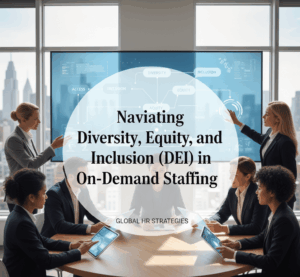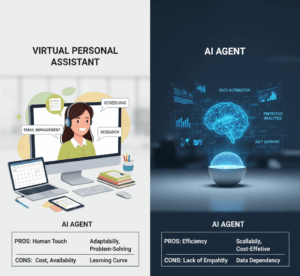
Introduction to Talent Acquisition and Its Importance
Talent acquisition is the strategic process of identifying, attracting, and hiring top talent to meet an organisation’s needs. It goes beyond mere recruitment by focusing on long-term human resources planning and finding candidates who not only fit the current job requirements but also align with the company’s culture and future growth plans.
The importance of talent acquisition cannot be overstated. Effective talent acquisition helps organisations build a robust talent pipeline, reduce turnover rates, and ensure that the right people are in place to drive business success. It also involves employer branding, candidate experience management, and leveraging data analytics to make informed hiring decisions
The Significance of Inclusivity in Talent Acquisition
Inclusivity in talent acquisition means ensuring that the hiring process is fair and equitable for all candidates, regardless of their background, gender, ethnicity, age, or other personal characteristics. An inclusive approach to talent acquisition helps to build a diverse workforce, which has been shown to foster innovation, improve employee engagement, and enhance overall business performance.
Inclusive talent acquisition also reflects a company’s commitment to diversity, equity, and inclusion (DEI), which is increasingly important to job seekers and consumers alike. Companies that prioritise inclusivity are better positioned to attract a wider range of candidates, create a more dynamic and creative work environment, and build a positive reputation in the market
Understanding Inclusive Talent Acquisition
Definition and Key Components
Inclusive talent acquisition refers to the deliberate efforts to ensure that recruitment processes are unbiased and accessible to all potential candidates. Key components of an inclusive talent acquisition strategy include:
- Unbiased Job Descriptions: Crafting job descriptions that use inclusive language and avoid gendered or culturally specific terms.
- Diverse Recruitment Channels: Utilising a variety of platforms and networks to reach a wide range of candidates, including those from underrepresented groups.
- Equitable Interview Processes: Standardising interview questions and using diverse interview panels to ensure fairness.
- Bias Training for Recruiters: Providing training for hiring managers and recruiters to recognize and mitigate unconscious biases.
- Accessibility: Ensuring that the application and interview process is accessible to candidates with disabilities
Benefits of an Inclusive Talent Acquisition Strategy
- Enhanced Innovation and Creativity: Diverse teams bring different perspectives and ideas, which can lead to more innovative solutions and products.
- Improved Employee Engagement and Retention: Employees who feel valued and included are more likely to be engaged and stay with the company longer.
- Broader Talent Pool: By reaching out to a more diverse range of candidates, companies can tap into a wider array of skills and experiences.
- Positive Employer Brand: Companies known for their commitment to inclusivity are more attractive to job seekers and can build a stronger employer brand.
- Compliance and Risk Management: Ensuring that hiring practices comply with anti-discrimination laws and regulations reduces the risk of legal issues.
By understanding and implementing inclusive talent acquisition strategies, companies can not only build a diverse workforce but also foster a more inclusive and equitable work environment that drives overall business success.
Steps to Create an Inclusive Talent Acquisition Strategy
1. Evaluate Your Current Process
Conduct a Diversity Audit A diversity audit involves assessing your current workforce and hiring practices to identify areas where diversity is lacking. This includes reviewing demographic data, employee feedback, and hiring outcomes to understand how well your current processes are working.
Identify Gaps and Areas for Improvement Once the audit is complete, identify specific gaps in your hiring process. This might include a lack of diversity in certain departments, biassed job descriptions, or an interview process that inadvertently favours certain groups. Use this information to develop targeted strategies to address these issues
2. Set Clear Diversity and Inclusion Goals
Establish Measurable Objectives Set clear, measurable goals for diversity and inclusion within your organisation. These objectives should be specific, achievable, and time-bound. Examples include increasing the percentage of hires from underrepresented groups by a certain amount within a year or improving diversity in leadership roles
Align Goals with Overall Business Strategy Ensure that your diversity and inclusion goals are aligned with your broader business objectives. This alignment helps integrate inclusivity into the core of your company’s operations and makes it a priority for all stakeholders
3. Develop Inclusive Job Descriptions
Use Inclusive Language Craft job descriptions that use inclusive language to attract a broader range of candidates. Avoid jargon and terms that may be biassed or exclusionary. Tools like gender decoders can help ensure your language is neutral
Avoid Bias and Gendered Terms Remove any biassed language or gendered terms from job descriptions. For example, words like “rockstar” or “ninja” can deter certain groups from applying. Focus on the skills and qualifications necessary for the job without implying a preference for a specific type of candidate
4. Expand Your Talent Pool
Partner with Diverse Organisations and Groups Collaborate with organisations and groups that support underrepresented communities. This can include minority-serving institutions, professional associations, and community groups
Utilise Diverse Job Boards and Platforms Post job openings on diverse job boards and platforms that cater to specific demographics. This helps ensure your job postings reach a wider audience and attract a more diverse pool of candidates
5. Implement Unbiased Recruitment Practices
Use Blind Recruitment Techniques Blind recruitment involves removing personal information (e.g., name, age, gender) from applications to prevent unconscious bias during the initial screening process. This technique ensures that candidates are evaluated solely on their skills and qualifications
Train Hiring Managers on Unconscious Bias Provide training for hiring managers and recruiters on how to recognise and mitigate unconscious bias. This training can help create a more equitable hiring process and ensure that all candidates are given a fair chance
6. Create an Inclusive Interview Process
Standardise Interview Questions Develop a set of standardised interview questions that are asked of all candidates. This ensures consistency and fairness in the evaluation process and reduces the likelihood of bias
Ensure Diverse Interview Panels Assemble diverse interview panels to bring varied perspectives into the hiring process. This not only helps reduce bias but also makes candidates from underrepresented groups feel more welcome and comfortable
7. Promote an Inclusive Company Culture
Foster an Environment of Belonging Create a workplace culture where all employees feel valued and included. This can be achieved through inclusive policies, regular DEI training, and promoting open dialogue about diversity and inclusion
Encourage Employee Resource Groups Support the formation of employee resource groups (ERGs) that provide a space for employees from similar backgrounds to connect and support each other. ERGs can also offer valuable insights into how the company can improve its inclusivity efforts
8. Measure and Adjust Your Strategy
Track Diversity Metrics Regularly monitor and report on diversity metrics to track the effectiveness of your inclusivity efforts. This includes data on the diversity of your applicants, hires, and current workforce
Regularly Review and Refine Your Approach Continuously review your talent acquisition strategy and make adjustments as needed. Use feedback from employees and data from your diversity metrics to identify areas for improvement and implement changes accordingly
By following these steps, organisations can create a more inclusive talent acquisition strategy that not only attracts a diverse range of candidates but also fosters a culture of belonging and equity within the workplace.
The Role of Technology in Inclusive Talent Acquisition
Use of AI and Analytics in Removing Bias
Technology plays a crucial role in enhancing the inclusivity of talent acquisition processes. Artificial Intelligence (AI) and analytics can significantly reduce biases that often creep into traditional hiring methods. Here’s how:
- AI-Powered Screening: AI tools can automate the initial screening process, focusing solely on candidates’ skills and qualifications. By eliminating personal identifiers such as names, ages, and genders, AI helps ensure that candidates are assessed purely on their merit
- Predictive Analytics: Analytics tools can identify patterns and trends in hiring data, providing insights into where biases may exist and suggesting corrective actions. For instance, predictive analytics can reveal if certain demographics are consistently being overlooked at specific stages of the hiring process
- Talent Assessments: Platforms like TestGorilla use objective talent assessments to evaluate candidates’ capabilities, reducing reliance on potentially biassed resumes and interviews
- Structured Interviews: AI can help create and enforce structured interview processes by ensuring all candidates are asked the same questions and their responses are evaluated against the same criteria
Tools and Platforms that Support Inclusive Hiring
Several tools and platforms are designed to support inclusive hiring practices:
- StaffNow: As a comprehensive hiring solution, StaffNow connects businesses with on-demand talent, providing flexibility and ensuring a diverse pool of candidates is available whenever needed.
Conclusion
Inclusivity in talent acquisition is not only a moral imperative but also a strategic advantage. An inclusive hiring process ensures that all candidates are given a fair opportunity, leading to a more diverse workforce. This diversity drives innovation, enhances employee engagement, and ultimately contributes to better business outcomes. By adopting inclusive hiring practices, companies can attract a wider range of talent and build a stronger, more resilient workforce.
Start Implementing Inclusive Strategies
Businesses should begin implementing inclusive strategies to not only comply with evolving societal expectations but also to gain a competitive edge. Embracing inclusivity in talent acquisition can lead to significant improvements in creativity, employee satisfaction, and market reputation.
Get in Touch and Let’s Discuss Your Requirements
Reach for the Stars with StaffNow
At StaffNow, we recognise that each profession holds its own set of distinctive demands. We help connect businesses with on-demand talent, hour by hour. Whether you need support for a short-term project or are looking to fill a long-term position, StaffNow provides the experienced candidates you need, exactly when you need them.
Explore More Insights

The Impact of Hybrid and Remote Work on Hourly Staffing Trends for UK SMEs
Get in Touch The Impact of Hybrid and Remote Work on Hourly Staffing Trends for UK SMEs Did you know that in 2025, 74% of UK organisations have hybrid working

Skills-Based Hiring in the Flexible Workforce: Strategies for UK SMEs
Get in Touch Skills-Based Hiring in the Flexible Workforce: Strategies for UK SMEs Did you know that 90% of UK SMEs are grappling with skills gaps in their workforce, making

Navigating Diversity, Equity, and Inclusion (DEI) in On-Demand Staffing
Get in Touch Should You Hire a Virtual Personal Assistant or Build an AI Agent? Pros and Cons Did you know that UK SMEs with mature DEI practices see employees

Ethical AI in Recruitment: Mitigating Bias in Candidate Matching
Get in Touch Ethical AI in Recruitment: Mitigating Bias in Candidate Matching Did you know that by 2025, 70% of HR departments are predicted to use AI for core recruitment

Should You Hire a Virtual Personal Assistant or Build an AI Agent? Pros and Cons
Should You Hire a Virtual Personal Assistant or Build an AI Agent? Pros and Cons Get in Touch In today’s fast-paced digital landscape, where businesses strive for efficiency and innovation,

Human Virtual Assistants vs. AI Agents: Pros and Cons for Your Business
Human Virtual Assistants vs. AI Agents: Pros and Cons for Your Business Get in Touch “Can AI truly outperform a human virtual assistant, or is the human touch still the

